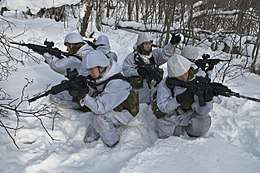All round defence
All-around defence[1] and perimeter defence[2] are synonyms for one category of the (relative) positioning of defensive fighting positions that are supposed to give military units and sub-units the ability "to repel an attack from any direction by being organized or sited for all round defence".[3] This defence can be used by military units from squad up.
This defence is adopted so that the unit is capable of observing all ground and directing fire onto the observed ground.
Definition
This defence can be defined as "a defence without an exposed flank, consisting of forces deployed along the perimeter of the defended area".[4]
Positioning of the outer defensive fighting positions
The positioning of the outer defensive fighting positions—relative to each other—of a platoon, can be traced as "circular or triangular rather than linear",[5] from a bird's-eye view.
In a circle
One version of a specific type of layout of fighting positions, consists of soldiers forming a wide circle around the soldier in charge (and radioman etc.) with a spacing typically of 3–4 metres between each person (on the circle's circumference). In situations with more than one platoon or squad, more than one all round defence will typically be formed about 20 metres away from each other. It is a useful formation because it allows a full 360° arc of fire, and because everybody is spread out, if the formation is attacked, by direct or indirect fire, the formation will minimise casualties.
Without cover

When a group of soldiers relocate as a part of a defensive operation, a perimeter defence can be temporarily maintained without cover.
This defence is typically used in any situation where a small unit would need to regroup—including after an attack.
References
- The term "all-around defense" used in a newspaper in 1944
- http://www.marines.mil/news/publications/Documents/FM%203-21.8%20%20The%20Infantry%20Rifle%20Platoon%20and%20Squad_5.pdf "8-133. A perimeter defense allows the defending force to orient in all directions."
- "Archived copy" (PDF). Archived from the original (PDF) on 2016-03-04. Retrieved 2012-04-27.CS1 maint: archived copy as title (link)
- http://www.answers.com/topic/perimeter-defense
- http://www.marines.mil/news/publications/Documents/FM%203-21.8%20%20The%20Infantry%20Rifle%20Platoon%20and%20Squad_5.pdf "The trace of the platoon is circular or triangular rather than linear"